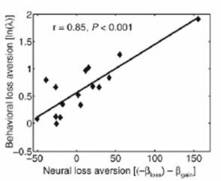Think about your friend offering you a bet over lunch. You have an equal chance of winning or losing. If you lose, you have to give him the candy bar you brought for dessert; if you win, he has to give you his dessert. How much better would his dessert have to be for you to make the wager? Better than your dessert, right? In fact, prospect theorists claim that when faced with a 50/50 chance of losing an amount of money or gaining some other amount, the potential gain has to be twice as much as the potential loss before people will accept the gamble (Kahneman & Tversky, 1979). This is because people tend to be loss averse: they assign greater weight to losses than gains. A recent study by Tom, Foxx, Trepel, and Poldrack (2007) investigated which areas of the brain are involved in these types of risky decisions. The researchers tested two possibilities that could account for loss aversion: (a) separate brain systems process gains and losses, with losses activating systems involved in processing emotions like fear and anxiety; or (b) the same brain system processes gains and losses, but represents them differently.
Tom et al. (2007) used an fMRI to scan nine female and seven male participants while they decided whether to accept a series of 256 gambles. All gambles had a 50/50 chance of winning from $10 to $40 or losing from $5 to $20. Participants received all possible win/loss combinations (e.g., a chance of winning $20 or losing $6) and selected whether they would “strongly accept,” “weakly accept,” “weakly reject,” or “strongly reject,” each gamble. To isolate the areas of the brain involved in evaluating gambles from areas involved in reacting to wins and losses, participants did not learn about the outcomes of their gambles during the scanning procedure. However, participants did bring their own money ($30 of their own and $30 provided by the researchers) to the experiment and believed that a random selection of three of the gambles they evaluated would be used to calculate their win or loss for the session.
As predicted by prospect theory, participants, on average, did not accept gambles unless the potential gain was approximately twice the potential loss. FMRI analyses showed that the greater the possible gain, the more certain brain systems known to be involved in anticipating reward(1) were activated. The greater the possible loss, the less those same systems were activated. Importantly, greater losses did not differentially activate any other brain systems, and areas such as the limbic system, which are involved in processing emotion, were not activated by increasing gains or losses.
Figure 1. Individual differences in behavioral and neural loss aversion (reproduced from Tom et al., 2007). 
These results support hypothesis (b): the same brain system processes gains and losses. In fact, the researchers found that the decrease in activity in that system in response to greater possible loss was greater than the increase in activity in response to greater possible gain, suggesting that the brain itself is weighting wins and losses differently. These brain activation patterns also reflected individual differences in loss aversion. As Figure 1 shows, people who accepted riskier gambles (i.e., those lower on behavioral loss aversion) had less activation in response to increasing possible gains and less decrease in activation in response to increasing losses (i.e., lower neural loss aversion); those who were more loss averse had higher activation in response to increasing possible gains and greater decrease in activation in response to possible losses (i.e., higher neural loss aversion). Put simply, those who made riskier bets were less sensitive (neurally) to the possible gains or losses.
The current study was limited in ways common to fMRI studies and gambling experiments: the sample was small, there might have been brain activation in areas not measured by the researchers, and it was impossible to create a realistic gambling context within the scanner (though the study did allow participants to put their own money at risk). Despite these limitations, the study supported prospect theory’s prediction that people weight losses twice as much as gains, suggested that this behavior can be explained by the greater sensitivity of a single brain system to losses than wins, and showed that behavioral differences in accepting or rejecting risky gambles are reflected by different levels of activation within that brain system. These findings indicate that the average person might have a hardwired predisposition to be risk averse. Conducting a similar study with disordered gamblers might demonstrate whether these gamblers utilize the same brain systems in evaluating gambles (presumably scoring on the low end of neural loss aversion) or whether they process these gambles in a qualitatively distinct way, using different brain circuitry than the participants in the current study.
What do you think? Comments on this article can be addressed to Sarah Nelson.
Notes
1. Specifically, the researchers found that the ventromedial prefrontal cortex, anterior cingulate cortex (ACC), and orbitofrontal cortex (OFC) showed both increased activity in response to greater gains, and decreased activation in response to greater losses.
References
Kahneman, D. & Tversky, A. (1979). Prospect theory: An analysis of decision under risk. Econometrica, 47, 263-291.
Tom, S. M., Fox, C. R., Trepel, C., & Poldrack, R. A. (2007). The neural basis of loss aversion in decision-making under risk. Science, 315, 515-518.




